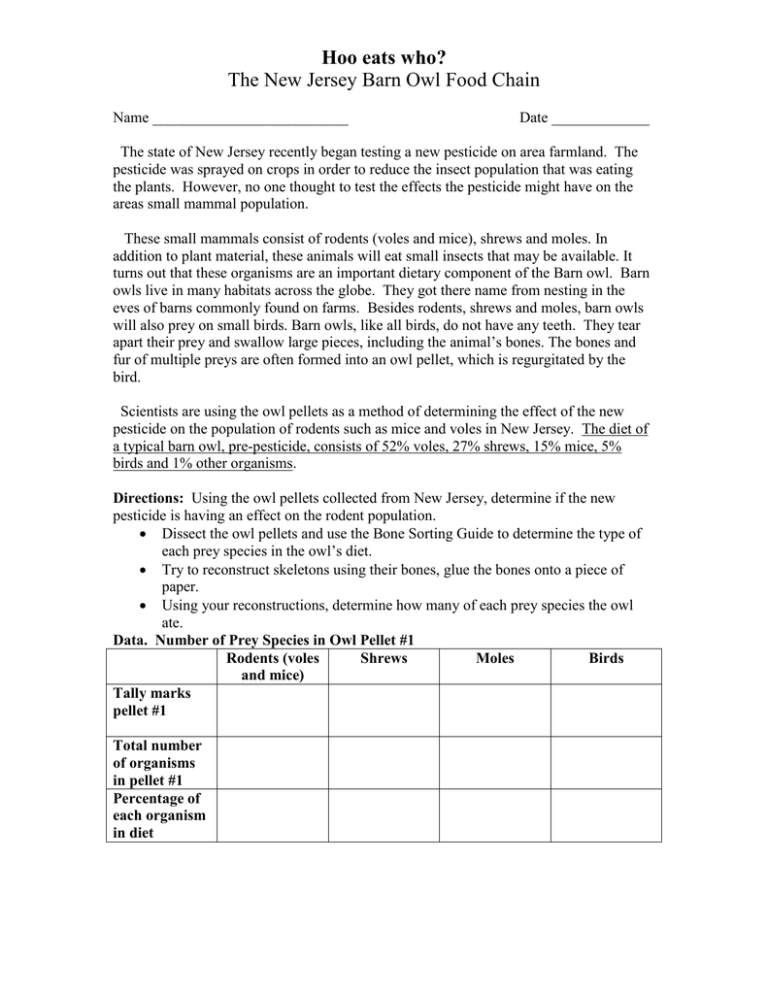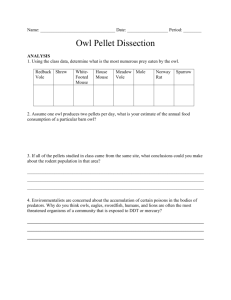Hoo eats who? The New Jersey Barn Owl Food Chain
advertisement

Hoo eats who? The New Jersey Barn Owl Food Chain Name __________________________ Date _____________ The state of New Jersey recently began testing a new pesticide on area farmland. The pesticide was sprayed on crops in order to reduce the insect population that was eating the plants. However, no one thought to test the effects the pesticide might have on the areas small mammal population. These small mammals consist of rodents (voles and mice), shrews and moles. In addition to plant material, these animals will eat small insects that may be available. It turns out that these organisms are an important dietary component of the Barn owl. Barn owls live in many habitats across the globe. They got there name from nesting in the eves of barns commonly found on farms. Besides rodents, shrews and moles, barn owls will also prey on small birds. Barn owls, like all birds, do not have any teeth. They tear apart their prey and swallow large pieces, including the animal’s bones. The bones and fur of multiple preys are often formed into an owl pellet, which is regurgitated by the bird. Scientists are using the owl pellets as a method of determining the effect of the new pesticide on the population of rodents such as mice and voles in New Jersey. The diet of a typical barn owl, pre-pesticide, consists of 52% voles, 27% shrews, 15% mice, 5% birds and 1% other organisms. Directions: Using the owl pellets collected from New Jersey, determine if the new pesticide is having an effect on the rodent population. Dissect the owl pellets and use the Bone Sorting Guide to determine the type of each prey species in the owl’s diet. Try to reconstruct skeletons using their bones, glue the bones onto a piece of paper. Using your reconstructions, determine how many of each prey species the owl ate. Data. Number of Prey Species in Owl Pellet #1 Rodents (voles Shrews Moles Birds and mice) Tally marks pellet #1 Total number of organisms in pellet #1 Percentage of each organism in diet Hoo eats who? The New Jersey Barn Owl Food Chain Data. Number of Prey Species in Owl Pellet #2 Rodents (voles Shrews and mice) Tally marks pellet #2 Moles Birds Total number of organisms in pellet #2 Percentage of each organism in diet Class Data on Barn Owl Diet Group # of Rodents Totals Percentage of organism in Barn owl diet. # of Shrews # of Moles # of Birds Hoo eats who? The New Jersey Barn Owl Food Chain Analysis. 1. In the space below, draw a diagram of the Barn owl’s food web. Be sure to include each trophic level that energy flows through in this ecosystem. Label the trophic level in which the pesticide begins to accumulate. 2. Explain the type of community interaction exists between the Barn owl and the rodents. 3. Are there more Barn owls or more rodents in this ecosystem? Explain your reasoning. Hoo eats who? The New Jersey Barn Owl Food Chain 4. Based on the owl pellets you dissected and the information about the Barn owl’s diet from the introduction, does the pesticide effect the local rodent population? Support your answer with data. 5. Now look at the class data. Does observing a greater number of owl pellets make a difference in your conclusion about the effect of the pesticide on the rodent population? Explain why and if, so what is your new conclusion? 6. Refer to your food web from question one. Explain which organism in the food web would be most affected by the biomagnification of the pesticide.


